Poland and the EU authorities have clashed on a number of issues. In addition, Warsaw plays a key role in the ongoing Russian invasion of Ukraine. However, since 1989, Poland has experienced unparalleled economic growth.
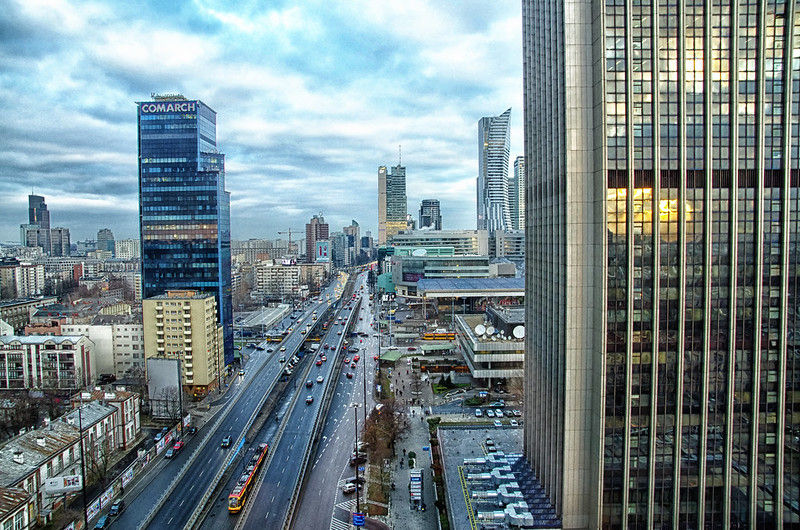
In recent years, Poland and the EU authorities have clashed on various issues. A recent case was in October 2021, when the current President of the European Commission, Ursula Von der Leyen, warned the Polish government that if it continued its authoritarian drift and questioned the primacy of European law over national law, she could freeze European funds post-SARS-CoV-2.
The ongoing Russian invasion of Ukraine calmed the waters somewhat, and Warsaw (as of today, March 29, 2022) welcomed more than 2.3 million people from Ukraine on their way to Poland, according to the most recent data from the UNHCR office. As a result, Poland now hosts one of the largest refugee populations in the world.
However, on the economic front, according to OECD data, Poland's GDP surpassed its pre-pandemic level and is expected to grow by 5.3% in 2021. With an uninterrupted pace of high growth averaging 4.2% per year between 1992-2019, Poland has been quietly and steadily growing economically and geopolitically. This article aims to shed light on how and what Poland's economic prospects are.
The recent history of this state dates back to after the end of World War I (1914-1918). Poland regained its independence in 1918. This new state faced the task of establishing political and economic unity after a century and a half of partition. At the same time, 75% of Polish society lived in the countryside, and there was a dominance of small-area farms.
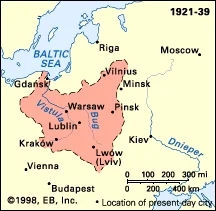
Map 1: Poland's borders in the interwar period. Source: https://www.britannica.com/event/Russo-Polish-War-1919-1920
From 1919 to 1920, Warsaw was at war with the Soviet Union. During this war, the Polish authorities decided to control prices and distribution of basic consumer goods, regulate foreign trade and exercise close supervision over banking, finance and industry. On March 18, 1921, the Treaty of Riga was signed, where most of Ukraine would remain a Soviet republic, although parts of Belarus and Ukraine were ceded back to Poland.
After this war, in 1923, Poland experienced a period of hyperinflation and, in April 1924, the Polish Prime Minister, Władysław Grabski, undertook a series of reforms, where the treasury was reorganized instituting a new Polish currency (the zloty) and the Polski Bank was founded, assuming the role of central and issuing bank and, will allow stabilizing the economy until 1925.
In the summer of 1925, Poland faced a new crisis due to the end of the most favored nation policy imposed on Germany by the Treaty of Versailles (1919) and the end of the German-Polish Convention on Upper Silesia (1922).
In the summer of 1925, Germany launched a "tariff war" against Poland. Deutsche Bank sold large quantities of the new Polish currency on the Berlin and Vienna money markets. Consequently, the złoty lost almost 50% of its original value in gold, prices rose and unemployment increased, forcing Grabski's resignation in November 1925.
In May 1926, the Polish head of state, Józef Piłsudski, staged a successful coup d'état against the government led by Wincenty Witos.
In the same year, there was an increase in local investments and state production and, the construction of the Silesian-Pomeranian railroad began, key to the development of the port of Gydnia and, increasing coal exports to other states.
In addition, Piłsudski wanted to resurrect an updated and democratic form of the Polish-Lithuanian Commonwealth, for which he saw the Intermarium federation (now known as the Three Seas Initiative) (I3M), key to countering Russian and German imperialism.
The Great Recession of 1929 hit Poland hard. It should be mentioned that there was a 65% drop in agricultural production, 61% in steel production and 13.9% in the metallurgical industry. The unemployment rate exceeded 43% and in order to face this crisis, the Polish government used deflationary methods: fixing an exchange rate, stopping the flow of foreign currency, reducing investment funds and budget cuts. Many companies were seized by the Polish authorities due to the inability to repay loans.
In 1931, the tariff dispute with Germany was finally settled and, in 1936, Eugeniusz Kwiatkowski introduced the Four-Year Plan. This program was intended to promote the development of the weapons industry, heavy industry, mining, chemicals, etc., and was carried out in the Warsaw Industrial Region and in Gdynia. In 1938, Poland (taking into account the GDP per capita) was more prosperous than Portugal, Greece and Spain. However, in September 1939, Nazi Germany invaded Poland, starting World War II.
During WWII, Poland suffered enormous losses, both in human and economic terms. According to estimates by the Office of War Compensation (created at the end of the war by the communist authorities), the damage resulting from the German occupation amounted to some $650 billion (about twice the annual Norwegian GDP).
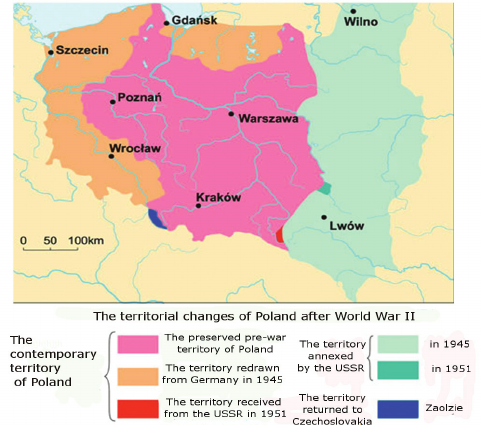
Map 2: territorial changes in Poland during the 20th century. Source: https://www.researchgate.net/figure/Polands-territorial-changes-after-the-Second-World-War-Source-based-on-Wydawnictwo_fig2_268517899
After World War II (1939-1945), Poland found itself in the sphere of influence of the Soviet Union and, in Warsaw, the system was less repressive and strict in economic and social matters than in other Soviet republics.
Nevertheless, the Soviet authorities had to rebuild infrastructure, factories and practically entire cities (as in the case of Warsaw). In addition, the socialist system introduced a centrally planned economy, nationalized industry and fought against private enterprise.
Since the 1970s, the Polish economy began to stagnate, due to an outdated industrial infrastructure, government subsidies that masked inefficient production and artificially high wages relative to productivity. These problems worsened during the 1980s, growing public deficits and hyperinflation led to an economic crisis.
To this, in this decade, the Solidarity union was founded and Leszek Balcerowicz, would be part of this organization. This union gained popularity after the widespread labor unrest of 1981. These riots led to the declaration of martial law by the government in December and to the arrest and detention of Solidarity's leader, Lech Wałęsa. After martial law, this union was declared illegal, but continued to have influence as an underground organization.
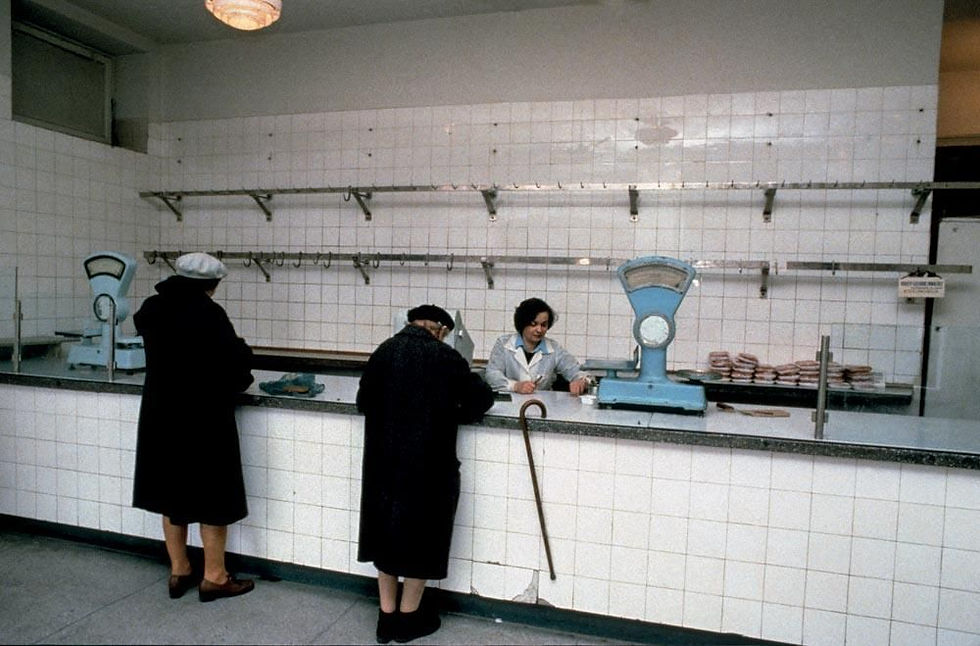
Image 1: photo of a Meat Store, Warsaw 1982. Source: https://lithub.com/the-lessons-of-my-childhood-in-communist-poland-are-relevant-again/
Prior to 1990, private sector goods and services accounted for less than a quarter of total GDP and were largely concentrated in agriculture, services and small industry.
In 1988, further labor unrest and nationwide strikes forced negotiations between the Soviet authorities and Solidarity. These led to the legalization of this union and the convening of Poland's first free elections since World War II.
On June 4, 1989, the communists were defeated in the Polish parliamentary elections, the first country in the world to abandon communism, and the country experienced an economic miracle. Poland lived under a scenario of hyperinflation and shortages that plagued the economy and the state-owned industrial plants were increasingly inefficient.
Under this situation of an outdated economic model and a deep macroeconomic crisis, in January 1990, the post-communist Polish government, led by Lech Wałęsa, introduced one of the most radical and far-reaching economic reform programs ever undertaken in any country during this century; known as, the Balcerowicz Plan or shock therapy.
The aim was to halt Poland's financial and structural crisis and to quickly convert the communist economic model into a free market system, thus reintegrating Poland into the world economy.
On the one hand, the exchange rate of the złoty, Poland's currency, was allowed to be freely fixed on international currency markets. In 1995, a new devalued złoty was introduced, which was equivalent to 10,000 of the old złotys. On the other hand, one of the most important challenges in this economic transition was the privatization of the largest enterprises was more complicated.
To address this issue, in 1994, the Mass Privatization Program was introduced. Fifteen national investment funds (NIFs) were created to serve as joint stock companies for more than 500 large and medium-sized enterprises that were privatized. Poles could buy shares in these funds at a nominal price. The NIFs, which were listed on the Warsaw Stock Exchange, included a wide range of companies, allowing citizens to have a diversified stake in major Polish industries. In 2001, more than 6,800 state-owned enterprises were privatized and the private sector accounted for more than 70% of GDP.
The executive also achieved two major successes: the formal recognition of the Oder-Neisse border by reunified Germany and, following the dissolution of the Warsaw Pact in 1991, the evacuation of Soviet troops from the country in 1992.
In addition, in 1996, Poland became a member of the Council of Europe, establishing economic ties with the European Union (EU) and was admitted to the Organization for Economic Cooperation and Development. In 1999, Poland became a member of the North Atlantic Treaty Organization, despite Russian opposition. Warsaw also signed agreements with Ukraine and Lithuania and established limited regional cooperation by forming the Visegrad Group, together with the Czech Republic, Slovakia and Hungary.
On the economic side, more than half of the economy was privatized and was making significant progress, such as significantly reducing the annual inflation rate and the budget deficit. In addition, Poland's annual gross national product growth rate was the highest in Europe. It should be mentioned that: inflation started to decline from 250% in 1990 to 10% in 2000. Output and GDP also recorded a dramatic turnaround, with average annual GDP growth of around 4% between 1990 and 2000. Unemployment, which had been high at the beginning of the decade, was close to 10% by the end of the 1990s.
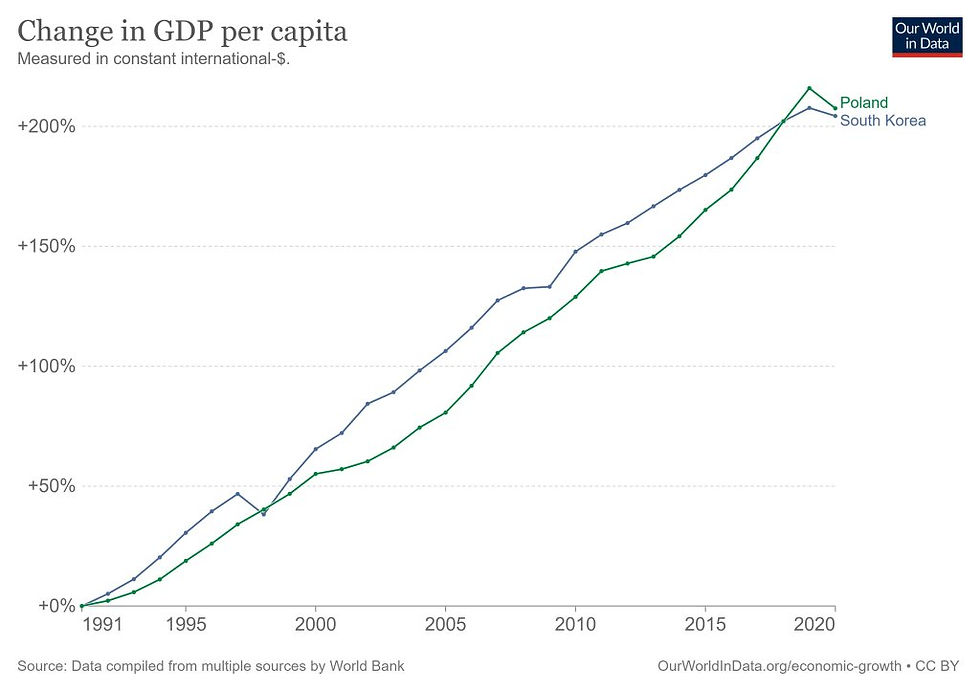
Figure 1: Evolution of GDP per capita (1991-2020) in Poland and South Korea. Source: https://twitter.com/juanrallo
In just 15 years, exports have grown from 34% of Gross Domestic Product (GDP) in 2004 to 55% in 2018. In addition, a little mentioned element that explains Poland's success is even representing quite different parties, the high quality of the political elites, especially the finance ministers and central bankers and, Polish officials knew exactly where they had to go.
Another key aspect that explains this economic growth is education.
In 1999, an educational reform was implemented. Warsaw implemented a more rigorous school curriculum, but with fewer subjects to be covered; schools were given more autonomy to choose textbooks from hundreds of pre-approved options for teaching and content" and, teachers were encouraged to stop working at a lower level and start training better, allowing them to achieve optimal performance in educating future generations. This change is reflected in developments in the PISA report. Polish schoolchildren are the third best in Europe in mathematics and science, and fourth in reading comprehension, according to the latest 2019 PISA international rankings.
In 2003, Poland experienced an economic slowdown accelerated by the global economic crisis and, in June 2003, voted in a referendum on whether it wanted to join the EU.
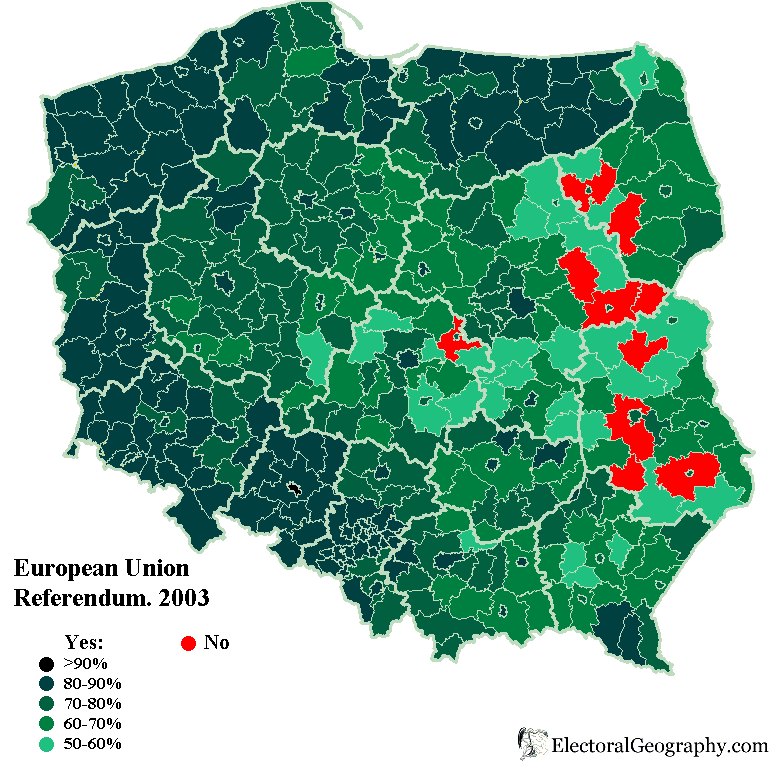
Map 3: Results of the 2003 referendum in Poland on whether or not to join the EU. Source: https://www.electoralgeography.com/new/en/countries/p/poland/poland-european-union-referendum-2003.html
Since 2004, it would become another EU member state without yet joining the euro. Nevertheless, the Polish economy recovered quickly and continued to grow even during the global financial crisis of 2008-09. Warsaw was the only European country whose economy did not go into recession.
This uniqueness is due to a number of factors. These include: fiscal and monetary stimulus, a large currency depreciation and a relatively large domestic economy, which limited the country's exposure to the downturn in international trade. In addition, growth was supported by increasing inflows of funds from the European Union. It should be mentioned that, Poland was the largest recipient of EU funds from 2007 to 2013 and from 2014 to 2020, with €102 billion and €106 billion of funds received and to be received, respectively, in each period.
Another highlight was a diversified export structure and sustained confidence among Polish consumers and entrepreneurs. In addition, Poland's banking sector was also healthy and Polish banks remained profitable, liquid and well capitalized during the crisis, without needing public support.
The 3 Seas Initiative (I3M), was formed in 2010 with the goal of developing and strengthening defense cooperation between member countries. It acts as a forum between twelve European countries to strengthen trade, energy, infrastructure and political cooperation. This bloc is made up of: Poland, Croatia, Czech Republic, Hungary, Romania, Slovakia, Bulgaria, Estonia, Lithuania, Austria, Latvia and Slovenia.
In 2018, the average income level in Poland exceeded two-thirds of the average level in the Eurozone. In terms of purchasing power, Poland's GDP per capita grew even faster, roasting from $10,300 in 1990 to over $28,000 in 2018 (in constant 2011 dollars).
However, in 2020, Poland experienced its first economic recession caused by SARS-CoV-2. Poland's GDP contracted by 3.5%, well below the OECD average of 5.5%. Official Polish unemployment figures have barely moved, and are the lowest in the EU according to the latest Eurostat figures.
The first case of Covid-19 appeared in Poland relatively late. During the first spring 2020 wave of the pandemic, Warsaw avoided the worst health ravages and avoided a heavy blow to its economy. This policy of early and tight restrictions avoided the painful trade-off between health and economy.
Alongside this, the composition of the Polish economy also makes it more resilient to shutdown measures. In 2019, 27% of workers were employed in the sectors that were later directly affected by the closure. It should also be included that, Poland is the only major EU country with a growing share of manufacturing in both employment and output. This kept a larger part of the economy going when the service sector had to close.
According to data from the European Bank for Reconstruction and Development (EBRD), it forecasts 3% growth in 2021, which would make Poland one of the few EU states to reach its pre-crisis level by the end of 2021.
Since the end of 2021, the EU has been experiencing an energy crisis due to rising gas prices. Consequently, in January 2022, the Polish executive announced the introduction of new financial aid for public institutions affected by rising gas prices, as the country struggles with its highest inflation in years, currently at 8.6%.
Along with that, in 2014, the war in Ukraine led to an increase in the number of Ukrainian refugees on Polish soil and, the ongoing Russian invasion of Ukraine in 2022 (as of April 2, 2022), more than 2,362,044 of Ukrainian citizens moved to Poland.
The Prime Minister, Mateusz Morawiecki, announced on Wednesday, March 30, 2022, measures to end all Russian oil imports by the end of 2022. Russian coal imports will be banned (20% of the total comes from Moscow) and he expects coal imports to end in May.
Warsaw is also taking steps to reduce its dependence on Russian gas. A liquefied gas terminal was built in Swinoujscie and is being expanded, receiving supplies from Qatar, the United States, Norway and other exporters. By the end of this year 2022, a new Baltic pipeline bringing gas from Norway will be inaugurated.
Alongside this, there is a heightened suspicion in Poland of the threats looming over them in the context of the Russia-Ukraine crisis. Beyond the possibility of waves of disinformation, cyberattacks and more of the kind of hybrid warfare Poland faced from Belarus last year, Russian forces stationed just 124 miles from Warsaw in Belarus have also put Poland on edge.
To this in recent years, tensions between Brussels and Warsaw have been increasing and, as in other EU states, Poland is facing a demographic crisis. According to a EUROPOP2019 forecast from Eurostat, they show that within three decades Poland's population will shrink by almost 3.9 million people, more than 10%.
Despite all these challenges, it should be noted that Poland has been one of the most resilient and fastest growing economies in Europe in recent decades, and is often described as a success story envied by many of its neighbors. To this, it was the only European economy that did not contract in 2009. Although it recorded its first recession in three decades in 2020, the country seems to have managed to mitigate the economic turbulence caused by the pandemic better than most. The ongoing Russian invasion of Ukraine will bring significant economic and geopolitical changes, where Poland will be a key player.
Recommended bibliography:
Piatkowski, M., 2019. Poland Is Europe’s Growth Champion. Can This Continue? - The Globalist. [online] The Globalist. Available at: https://www.theglobalist.com/poland-economy-gdp-european-union/
Investopedia. 2022. 4 Economic Challenges Facing Poland in 2020. [online] Available at: https://www.investopedia.com/articles/investing/011416/3-economic-challenges-poland-faces-2016.asp

Comments